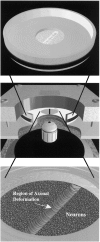High tolerance and delayed elastic response of cultured axons to dynamic stretch injury
- PMID: 10341230
- PMCID: PMC6782601
- DOI: 10.1523/JNEUROSCI.19-11-04263.1999
High tolerance and delayed elastic response of cultured axons to dynamic stretch injury
Abstract
Although axonal injury is a common feature of brain trauma, little is known of the immediate morphological responses of individual axons to mechanical injury. Here, we developed an in vitro model system that selectively stretches axons bridging two populations of human neurons derived from the cell line N-Tera2. We found that these axons demonstrated a remarkably high tolerance to dynamic stretch injury, with no primary axotomy at strains <65%. In addition, the axolemma remained impermeable to small molecules after injury unless axotomy had occurred. We also found that injured axons exhibited the behavior of "delayed elasticity" after injury, going from a straight orientation before injury to developing an undulating course as an immediate response to injury, yet gradually recovering their original orientation. Surprisingly, some portions of the axons were found to be up to 60% longer immediately after injury. Subsequent to returning to their original length, injured axons developed swellings of appearance remarkably similar to that found in brain-injured humans. These findings may offer insight into mechanical-loading conditions leading to traumatic axonal injury and into potential mechanisms of axon reassembly after brain trauma.
Figures






References
-
- Adams JH, Graham DI, Murray LS, Scott G. Diffuse axonal injury due to nonmissile head injury in humans: an analysis of 45 cases. Ann Neurol. 1982;12:557–563. - PubMed
-
- Adams JH, Doyle D, Graham DI. Diffuse axonal injury in head injuries caused by a fall. Lancet. 1984;2:1420–1422. - PubMed
-
- Adams JH, Doyle D, Ford I, Gennarelli TA, Graham DI, McClellan DR. Diffuse axonal injury in head injury: definition, diagnosis, and grading. Histopathology. 1989;15:49–59. - PubMed
-
- Burgoyne P. The neuronal cytoskeleton. Wiley; New York: 1991.
-
- De Gennes P-G. Scaling concepts in polymer physics. Cornell UP; Ithaca, NY: 1979.
Publication types
MeSH terms
Substances
Grants and funding
LinkOut - more resources
Full Text Sources
Other Literature Sources
